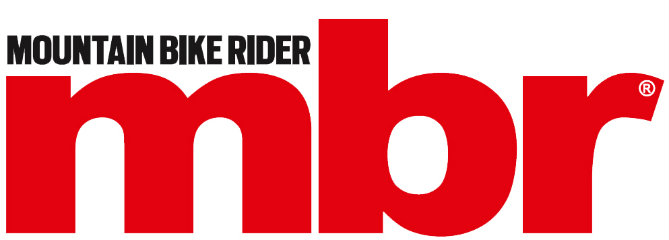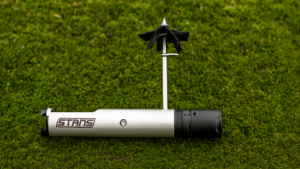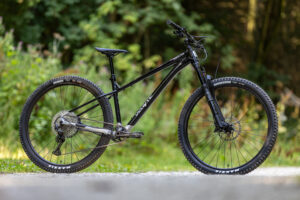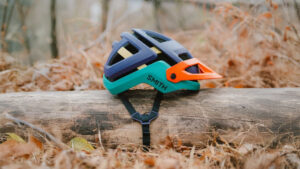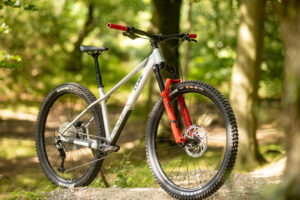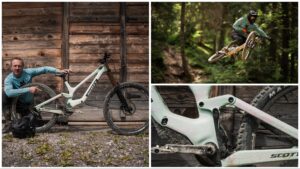These are best hardtail mountain bikes out there right now, whether you're looking for a top beginner mountain bike, back-to-basics trail hardtail, or flyweight XC race machine.
Best hardtail mountain bike: classic trail shredding machines
From budget hardtails to mid-range models and premium dream bikes, these are the best hardtail mountain bikes we’ve tested – and we’ve ridden a lot! Literally hundreds since we were founded back in 1997. Each of these bikes has been thoroughly tested by our expert team, so we can guarantee that which ever one you go for, it’ll be the best mountain bike for your budget.
Hardtails are a great choice for anyone looking for a budget mountain bike, beginners keen to get started with riding, and even for experienced trail riders looking for back-to-basics simplicity and raw fun.
Best hardtail mountain bikes – quick list
- Best value hardtail – Calibre Line T3-27
- Best lightweight budget hardtail – Voodoo Bizango Pro
- Best hardtail under £600 – Voodoo Braag
- Best money-no-object hardtail – Santa Cruz Chameleon

Calibre’s Line T3-27 is our latest Hardtail of the Year winner
1. Calibre Line T3-27
Best hardtail mountain bike under £1,000
Wheel size: 27.5in | Frame sizes: S, M, L, XL | Weight: 14.52kg | Suspension travel: 140mm front | Rating: 10/10
Reasons to buy:
-
-
- Modern geometry
- Dropper seatpost
- Large-volume tyres are comfortable and confidence-inspiring
-
Reasons to avoid:
-
-
- Needs a wider gear range
- tall bottom bracket height
-
Calibre is back in the game after a two-year hiatus, and it’s newest Line T3-27 is straight into the top of our hardtail charts with a perfect 10/10 rating. Built around progressive trail geometry and oversize tyres on 27.5in wheels, the Line T3-27 comes with a clear advantage on rough trails, with more grip and improved comfort.
Getting a dropper post as standard is another impressive feat on this budget bike, and helps the Calibre show a clean pair of heels to the competition on the descents. It’s also more comfortable on the climbs, as you don’t feel every bump travel through your spine. Given inflation over the last few years, the fast that you can get this level of performance for £1k is remarkable.
Listed retail price for the T3-27 is £12,00. However, if you sign up and buy a Go Outdoors membership card for just £5, the bike’s price drops to a great value £999.
Read our full review of the Calibre Line T3-27

Voodoo’s Bizango Pro is an absolute flyer
2. Voodoo Bizango Pro
Best budget mountain bike for racing and long rides
Wheel size: 29in | Frame sizes: S, M, L, XL | Weight: 13.2kg | Suspension travel: 130mm front | Rating: 10/10
Reasons to buy:
-
-
- Good geometry and superlative spec choices
- Low weight and comfy ride feel
-
Reasons to avoid:
-
-
- BB could be a finger’s width lower
- Fatter tyres and more standover clearance would be welcome
-
The Voodoo Bizango has smashed pretty much any test it’s ever entered, winning our Hardtail of the Year award multiple times, earning regular podium places on our list of the best hardtail mountain bikes, and impressing everyone who rode it. It must have been very tempting for Halfords to stick with the old frame, add a modern colour, fettle the spec and keep mixing up that winning mix.
We’re extremely glad they didn’t then. For Halfords’ sake, standing still in the ultra competitive hardtail market is suicide. And for our sake, the new Bizango Pro is much the superior bike to anything Voodoo has made before, and ultimately more fun to ride. Great brakes mean you can go faster in the happy knowledge you can stop when you need to, while the 12-speed shifting means you can cruise the hills faster than plenty of full-sus bikes out there. And then there’s the fork, it’s hugely superior to anything we’ve tried before on a £1k hardtail: air-sprung so you can set the sag to your weight, effective rebound dial for control, and a really smooth feel.
Read the full Voodoo Bizango Pro review

The Voodoo Bizango is a classic hardtail that still delivers the goods
3. Voodoo Bizango
Best hardtail mountain bike for £750
Wheel size: 29in | Frame sizes: S, M, L, XL | Weight: 13.1kg | Suspension travel: 120mm front | Rating: 10/10
Reasons to buy:
-
-
- The price
- Light weight
- Wide gear range
- Stable handling
-
Reasons to avoid:
-
-
- Not always in stock
-
The alloy Bizango simple has no competition. It is simply unbeatable for the money. In fact, given the choice we’d probably opt for this bike over many decent £1,000 mountain bikes (saving a couple of components upgrades for the ensuing seasons). Good brakes, good gearing, plenty of standover, decent fork. Shames many bikes at twice the price.
Read our full review of the Voodoo Bizango
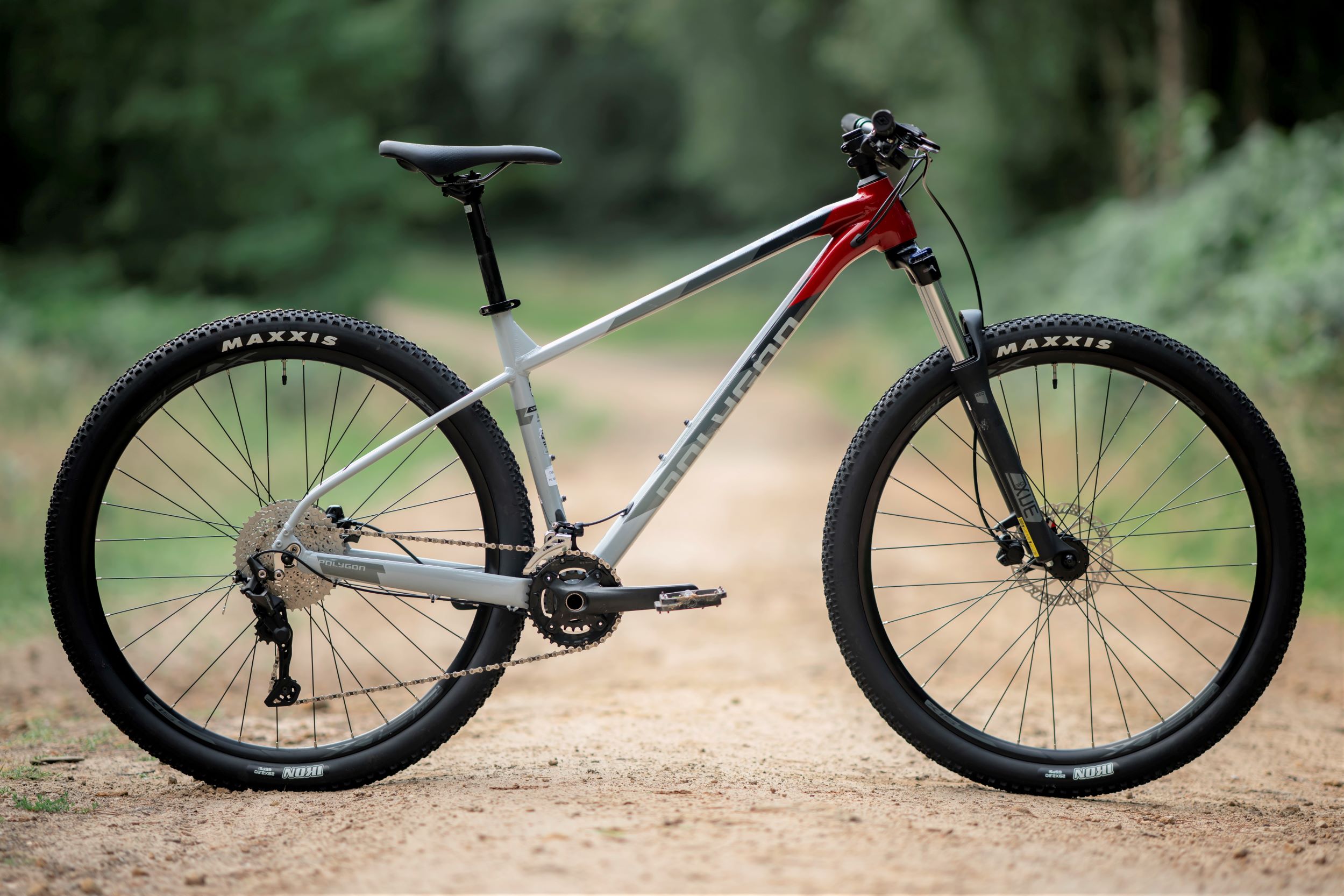
With a single-ring drivetrain, the Polygon Xtrada 5 would be a 10/10 bike
5. Polygon Xtrada 5
Best hardtail under £700 for upgrading
Wheel size: 29in | Frame sizes: S, M, L, XL | Weight: 14.31kg | Suspension travel: 120mm front | Rating: 9/10
Reasons to buy:
-
-
- A top quality frame with up-to-date geometry
- Loads of standover clearance
-
Reasons to avoid:
-
-
- Dated 2×10 drivetrain
- Fork tops out
-
The Polygon Xtrada 5 may well sport a dated 2×10 drivetrain, but this 29er has the slackest steering geometry for stability at speed, along with the lowest top tube and shortest seat tube to give you maximum range of motion on black-level trails.
While the drivetrain is frustrating, the handling is first class. It carries speed easily, and we could really throw it around on fun, technical trails and jumps.
Read our full review of the Polygon Xtrada 5

Voodoo’s Braag is a cracking entry-level mountain bike
6. Voodoo Braag
Best hardtail mountain bike for under £600
Wheel size: 29in | Frame sizes: S, M, L, XL | Weight: 14.6kg | Suspension travel: 120mm front | Rating: N/A
Reasons to buy:
-
-
- Amazing price
- Great geometry and range of sizes
- Spot-on cockpit and component choices
-
Reasons to avoid:
-
-
- The fork tops out with a clunk
-
Using the same frame as the multi award-winning Voodoo Bizango (featured below) the Braag saves money in a few areas to bring the price point under £600. So you get the same confident, fun handling and excellent spread of sizes, along with a wide-range yet simple 9-speed drivetrain and a plush coil-sprung suspension fork. The only fly in the ointment is that the fork can get a bit clunky, but overall this is a killer bike for the money and one you can upgrade as your skills progress.
Read our full review of the Voodoo Braag

Whyte’s 909 X Enduro hardtail, flying the flag for Plus-size tyres.
7. Whyte 909 X
Best trail hardtail for speed and comfort
Wheel size: 27.5in | Frame sizes: S, M, L, XL | Weight: 13.61kg | Suspension travel: 130mm front | Rating: 9/10
Reasons to buy:
-
-
- Superb ride quality
- Dialled geometry
- Neat details
-
Reasons to avoid:
-
-
- It’s expensive for a hardtail
-
Most of the hardtails featured here are 29ers, but we still think there’s a strong case for 27.5in wheels when shod with oversize 2.8in tyres. Why? Well they give more comfort, more grip, and more control, so you can ride them faster for longer. Whyte’s 909 proves that beyond doubt, reminding us why Plus-size tyres were such a big (if you’ll excuse the pun) thing just five years ago.
But the Whyte is more than just some fat rubber. It’s also a thoroughly modern frame that’s been refined over years of developing market-leading hardtails. And there’s a high-end spec with excellent RockShox suspension and wireless shifting.
Read our full review of the Whyte 909X

The Whyte 629 V4 comes from a long lineage of award-winning hardtails
8. Whyte 629 V4
Best trail hardtail with 29in wheels
Wheel size: 29in | Frame sizes: M, L, XL | Weight: 14.41kg | Suspension travel: 120mm f | Rating: 10/10
Reasons to buy:
-
-
- Amazingly composed and stable handling
-
Reasons to avoid:
-
-
- Low-profile rear tyre may not suit all conditions.
- No size small – for that you need the 27.5in wheel 901 or 905
-
Whyte has been on path to build the perfect trail hardtail for many years now, and the 629 V4 is really honing in on that goal. When we tested it we had this to say about it: ‘The Whyte 629 V4 really impressed us, and in many ways it mirrors its stablemate, the 905, in setting new hardtail standards, this time for 29ers. Ultimately it is balanced, composed, stable and precise, and whether you’re a relative beginner, or an experienced trail rider, you’ll instantly become addicted to its ways’.
Read our full review of the Whyte 629 V4

Merida’s not green around the gills when it comes to making a great hardcore hardtail.
9. Merida Big Trail
Best aggressive hardtail for ride feel
Wheel size: 29in | Frame sizes: X-short, short, medium, long, X-long | Weight: 14.48kg | Suspension travel: 140mm f | Rating: 9/10
Reasons to buy:
-
-
- Full-on radical enduro geometry
- Alloy frame with a steel feel up front
- Well-priced, and longevity-focused kit
- Long drop seat post ready
- Quiet cable routing
- Kickstand, rack, and whale tail or full fender compatible
-
Reasons to avoid:
-
-
- Headset cable routing is a potential DIY pain
- Low BB means more crank taps
- Only 2.4in of rear tyre clearance
- Takes a kickstand, which makes it 100 times less cool
-
Merida really took the hardcore hardtail seriously when it launched the Big Trail back in 2020. Pooling feedback from UK dealers into a frame specifically designed to meet the demands of British riders looking for a reliable, durable steed that can be ridden out of its skin. We’ve tested a couple of Big Trails in the intervening period, and we’ve sung the praises of all of them. The latest to pass through the MBR testing lab is the new Big Trail 600, and Guy Kesteven described it as the ‘life and soul of the party’, and ‘riotously enjoyable’. He also singled out the excellent geometry and forgiving ride feel of the quality frame, saying this bike is as much a daily driver as a weekend shredder. His only complaint was the headset-routed cables, which will be a headache for home mechanics.
Read our full review of the Merida Big Trail 600

Giant’s XTC SLR 29 1 is dressed to impress
10. Giant XTC SLR 29 1
Best budget XC race hardtail
Frame: ALUXX SLR aluminium | Frame sizes: S, M, L, XL | Suspension travel: 100mm f | Weight: 12.29kg (27.09lb) | Rating: 10/10
Reasons to buy:
-
-
- Giant Crest forks adds accuracy
-
Reasons to avoid:
-
-
- Needs lock-on grips
- Tall top tube height
-
A light frame, precise fork, and stellar handling ensured the Giant XTC emerged out in front when we tested four budget XC race hardtails. There’s an obvious pedigree bred from years of racing development, and the result is a bike that we described as “startlingly fast yet totally forgiving”.
Whether you’re planning to dip your toe into XC racing, have a crack at a marathon event, or fancy the challenge of a long-distance trail such as the South Downs Way, the Giant XTC SLR 29 1 is up for the fight.
Read our full test review of the Giant XTC SLR 29 1

The all-new, super-versatile Santa Cruz Chameleon
11. Santa Cruz Chameleon
Best money-no-object trail hardtail
Frame: Aluminium |Frame sizes: S, M, L, XL | Suspension travel: 130mm f | Weight: 14.19kg (31.28Ib) | Rating: N/A
Reasons to buy:
-
-
- Go anywhere, do anything attitude
- Mix-and-match wheel sizes along with adjustable chainstay length makes it very adaptable
- Short seat tube lengths let you upsize frames
-
Reasons to avoid:
-
-
- Expensive, given the SRAM NX drivetrain
- BB height could be lower
- No XXL size for really tall riders
-
While the Santa Cruz Chameleon might be old in years, it remains young at heart, with handling that is full of youthful exuberance and a frame that is totally modern. We love the adjustability, where slotted dropouts let you tune the chainstay length depending on the frame size and wheel diameter. Yes, as you’d expect from a Chameleon, it adapts to both 29in and 27.5in rear wheels depending on your preference.
It runs the perfect fork travel – 130mm – so you get enough control without massive swings in geometry as the fork compresses. It’s expensive, but it looks and feels premium, and the versatility is a cut above most other hardtails on the market.
Read our full test review of the Santa Cruz Chameleon

With MX wheels, the Saracen Mantra Trail is super trendy, and adheres to what we believe is the best template for a modern hardtail.
12. Saracen Mantra Trail
Best hardtail with MX wheels
Wheel size: MX (29in f / 27.5in r) | Frame sizes: S, M, L, XL | Weight: 14.46kg | Suspension travel: 140mm f | Rating: 8/10
Reasons to buy:
-
-
- Generous sizing and dialled geometry makes for a progressive ride
- Shimano Deore/SLX 12-speed drivetrain offers a wide gear range
- MX wheels offer more bum clearance for shorter riders
- Air-sprung 140mm RockShox fork is easy to adjust
-
Reasons to avoid:
-
-
- Needs tougher, softer compound tyres
- No chainstay protection, means you need ear defenders
- Inconsistent bite point on Shimano Deore rear brake is annoying
- Saracen missed a trick by not fitting wider tyres, especially on the rear
-
Most hardtails come with 29in wheels, but Saracen bucks the trend by choosing a mullet set-up with a big 29in wheel up front and smaller 27.5in hoop out back. This should give goof rolling speed up front along with more bum clearance and dynamic handling at the back for snappy cornering. Saracen also gives the Mantra Trail progressive geometry that begs to be ridden hard. When we tested it we were so close to being blown away. We loved the handling, superb frame quality, and value, but the narrow, hard tyres held back the performance. Thankfully that’s a relatively cheap and simple change. And with a grippier front tyre, and big volume 2.8in rubber out back, the Mantra Trail will enjoy more grip, more confidence, and better comfort.
Read our full review of the Saracen Mantra Trail
Also worth considering
There have been no shortage of hardtails through the doors of the MBR testing lab over the last 25 years. Our annual hardtail shoot-outs are renowned throughout the industry, and have helped us shape the modern hardtail. Of the bikes that we’ve tested that haven’t quite made the grade in this buyer’s guide, I’m going to start with the most recent – Marin’s San Quentin 1. This extremely hardcore hardtail looks like a cross between a dirt jump bike and a dual slalom racer. It has very progressive geometry and an ankle-high top tube that let us get really dynamic on the bike. However, we hated the way the fork topped out with a metallic clunk, we suffered terrible chainsuck from the drivetrain, and the tyres were harsh and drifty.

Specialized Epic Hardtail Comp – a decent competition bike.
If you’re looking for a race bike, the Specialized Epic Hardtail Comp is a decent option. We haven’t rated it yet, hence why it’s not in this guide, but we praised the light, reactive ride, and nicely-damped carbon frame when we rode it. However, Specialized needs to update the geometry and silence the cable rattle if it’s going to win a spot on our podium.
On One has been selling great value hardtails for longer than most, and built up a cult following. We tested the latest Scandal SX and liked the customisable spec, standard fit dropper post, and sculpted alloy frame. Less impressive was the upright riding position and short reach that made it skittish at speed. A problem not helped by the hard compound tyres.

Great spec, but little wheels and a frame that’s looking and feeling its age holds back the Carrera Fury.
Under the Halfords umbrella is the excellent Voodoo Bizango, but that’s not the only value hardtail sold by the motoring chain. Carrera’s Fury is less than £700 and a popular bike among young kids. We found that it showed lots of promise, with a great spec and top suspension fork for the price. But it was let down by the small wheels, punishing frame, and tall seat tube. A frame refresh could easily bring the Fury within striking distance of the Bizango.
As for the big names, Trek’s Roscoe 6 delivered a beautifully smooth ride thanks to the active fork and large volume tyres, but the rattle from the suspension and the excess weight hobbled the ride experience. The opposite was true for Specialized’s classic Rockhopper. This was light, fast, smooth and quiet, making it a lovely bike for covering ground on cruisy trails. But the old-school geometry and fast-rolling tyres held it back on more technical terrain.

All that glitters… Cube Attention SL didn’t sparkle on proper singletrack trails.
Another bike with one wheel in the past was the Cube Attention SL. This has a lovely lightweight frame that’s never harsh or edgy, so it’s a decent bike for rolling around forest tracks and dirt roads. However, the dated sizing and geonetry made it ride like a hardtail from a decade ago.
How we tested
All of the bikes recommended above have been thoroughly tested by the expert bike testers and reviewers at MBR. Many of them have been selected after head-to-head testing as part of our annual comprehensive Hardtail of the Year test. We ride each bike extensively in the terrain it was designed for, on mountain bike trails with a combination of climbing, descending and technical features to get the best possible understanding of the performance, strengths and weaknesses of each bike.

Looks nice… but is it the correct size?
What to look for in the best hardtail mountain bike
What is a hardtail mountain bike?
A hardtail is a mountain bike that has suspension at the front (a suspension fork) but has a rigid un-suspended main frame and rear wheel. The term hardtail differentiates it from full suspension bikes – with suspension at both wheels – as well as fully rigid bikes – which have rigid forks as well as rigid main frames.
What size frame should I buy?
Bike manufacturers use seat tube length to denote frame sizes. These can be in inches, or use descriptive terms like Small, Medium and Large. The problem is, there’s no standardised sizing tool, so one brand’s medium can be the same as another’s large.
Mountain biking is a dynamic sport, and you’ll be moving around the bike a lot when you’re riding. It follows, then, that you want plenty of clearance over the top tube when you’re standing astride the bike (called ‘standover’ height, and around three inches is a good starting point) but enough length between the seat and the handlebars that you don’t feel too cramped when sitting down and climbing.
Most brands will provide an online size guide, that will give you a recommended size based on your height. But be careful with these online size calculators as they’re not always that accurate. If in doubt, we’d recommend you go for the largest size you can get away with that still provides adequate standover clearance.
Read our guide: What mountain bike frame size should I ride?
What’s the best wheel size for a hardtail?
There are two main sizes of wheel on the market. They are 29in and 27.5in. So what are the pros and cons of each?
27.5in – Doesn’t roll as fast as 29in, but easier to turn and accelerate. Generally stronger and lighter than big wheels too. Paired with big volume tyres (2.5in and upwards) you get a more comfortable ride and improved grip.
29in – Rolls fast, more stable at speed and less interrupted by bumps, which makes them great on a hardtail, so long as the geometry is right. Wheels can be weaker and heavier though.
What are the best components – like forks, brakes and tyres – for a hardtail?
At the cheaper end of the market, try and choose a bike with an air-sprung fork. This will let you set adjust it to suit your body weight. Also try and get a fork with adjustable rebound damping at the minimum.
Disc brakes should be hydraulic, with replaceable brake pads. Some disc rotors only work with organic pad compounds, which wear quickly in the wet. A better option is to get a system that accepts sintered metal pads, as these are more durable.
While most new bikes come with inner tubes inside the tyres, a simple upgrade is to go tubeless, using liquid sealant inside the tyre to seal the air and even fix minor punctures without getting your hands dirty. So look for tubeless-ready tyres and wheels, to make the switch easier.
Don’t worry too much about things like grips and saddles, as these can be changed relatively cheaply at a later date to suit your personal preference.
Look for modern geometry
Good geometry (which goes hand-in-hand with frame-sizing) doesn’t increase the bottom line. Therefore quick-thinking smaller bike brands that aren’t asleep at the wheel can get ahead of their big-name rivals, or at the very least get a running start, by designing a frame with capable modern geometry.
Want to know what we mean by bike geometry and why it’s important to how your bike feels to ride? Read our deep dive on why geometry is so important.

Hardtails can be thrashed as hard as any bike
How do I get my new hardtail mountain bike set-up?
1. Inflate your tyres
Ignore the recommended tyre pressures printed on the sidewalls and aim for around 28psi front and 30psi rear – adjusting either way by a few psi if you weigh more or less than 75kg. Wide tyres can be run slightly softer than narrower ones, too – as low as 15psi for a 2.8in model.
Either way, too hard and they’ll be harsh and offer little grip; too soft and you’ll be more prone to pinch flats and you may even roll the tyre clean off the rim.
2. Adjust your handlebar controls
Disc brakes are so powerful you should only need to use one finger to slow down. Loosen the clamps and slide the levers away from the grips until your index finger rests right at the end of the lever blade. This gives you the most leverage and the most secure grip on the bars. Now slide your shifters against the brake clamps to make them accessible.
Your brake levers should be angled in line with your arms as they’re positions when you ride; don’t rotate them to point straight down.
3. Set your saddle position
Firstly, it’s critical you get the saddle height sorted for seated pedalling. As a rule of thumb, your leg should be straight, with your heel on the pedal and the crankarm in line with your extended leg. This allows for a slight bend in the knee when you place the ball of your foot on the pedal at your maximum saddle height.
For technical singletrack climbs, drop your saddle by 1-2cm to make balancing on the bike much easier. Slam the saddle all the way down for descending, and for the next step; setting your suspension…
4. Set-up your suspension fork
Don’t get distracted by handlebar lockouts as they aren’t much use off-road. Instead, focus on setting your sag correctly.
With an air-sprung fork start by using the recommendations printed on the leg. RockShox and Manitou have them, but not Suntour. You’ll need a shock pump to do this. If it has a lock out, check it’s in the open position first.
Now hop on the bike, lean against a wall and adopt the neutral riding position — out of the saddle with arms and legs bent. Bounce up and down on the fork and let it settle to the sagged position. The sag is how much the suspension compresses under your weight. Start with 20 to 25 per cent of the fork’s travel, so if you fork has 100mm of travel, it should compress by 20-25mm. Use the rubber O-ring or a zip tie on the leg to measure this.
Be sure to set the sag in your full riding kit, with backpack and water included.
5. Set your handlebar height
Finally, adjust your stem height. Raising your stem will give you more confidence on the descents, by making it much easier to shift your weight rearward. Too high, however, and you won’t have enough weight on the front tyre for grip on flat corners. It’s worth noting that stem height is closely related to fork set-up, as a combination of both will determine the height of the handlebar.

